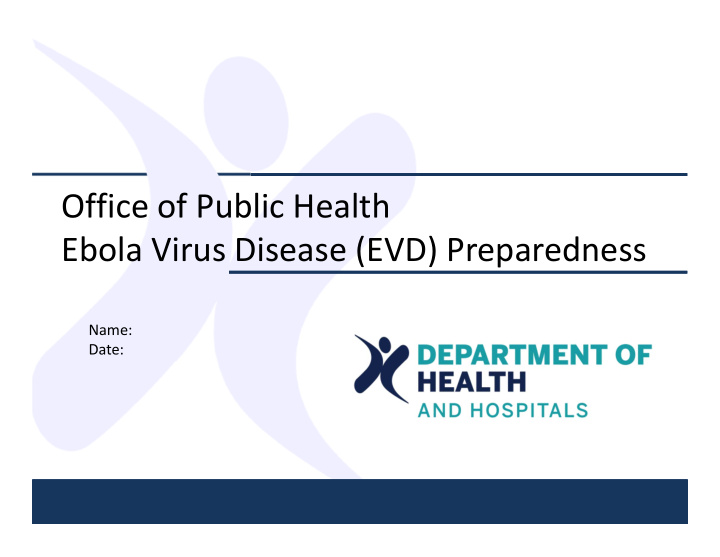



Office of Public Health Ebola Virus Disease (EVD) Preparedness Name: Date:
Ebola Virus Disease Source: CDC Ebola
Ebola Virus Disease (EVD) • Ebola Virus Disease (EVD) is a severe viral disease, caused by an infection with a species of Ebola virus. • In 1976, the first Ebola virus species was discovered in what is now the Democratic Republic of the Congo, near the Ebola River. • Since 1976, outbreaks have appeared sporadically.
Ebola Outbreaks 1976 ‐ 2014 Source: CDC Ebola
Current Ebola Situation Total Cases per CDC, West Africa (Updated October 3, 2014) Updated Case Counts available at http://www.cdc.gov/vhf/ebola/outbreaks/2014 ‐ west ‐ africa/index.html Countries with Outbreaks Totals for Guinea, Liberia & Sierra Leone Total Case Count: 7470 Total Deaths: 3431 Laboratory Confirmed Cases: 4087 Countries with Localized Transmission Nigeria Total Case Count: 20 Total Case Deaths: 8 Laboratory Confirmed Cases: 19 Source: http://www.gowestafrica.org/explore/
Current Ebola Situation Total Cases per CDC (Updated October 3, 2014) Updated Case Counts available at http://www.cdc.gov/vhf/ebola/outbreaks/2014 ‐ west ‐ africa/index.html Countries with Travel ‐ Associated Cases Senegal Total Case Count: 1 Total Case Deaths: 0 Laboratory Confirmed Cases: 1 United States (a traveler from Liberia) Total Case Count: 1 Total Case Deaths: 0 Laboratory Confirmed Cases: 1 Source:http://conexaoarabe.blogspot.com/2012/04/dakar ‐ senegal.html
Ebola Timeline Source: Key Messages ‐ Ebola Virus Disease, West Africa 10/2/2014
Transmission • Ebola is spread by direct contact with: Objects contaminated with the virus (Needles or medical supplies) Infected animals (Contact with blood or fluids) Body fluids of a symptomatic person • Blood • Stool • Urine • Saliva • Sweat • Other bodily fluids • Semen
Transmission • Ebola is not spread through the air, food, or by water • There is no evidence that mosquitos or other insects can transmit Ebola
Symptoms • Early symptoms include: • Fever (greater than 101.5 ◦ F) • Weakness • Muscle pain • Headache • Sore throat • Followed by vomiting and diarrhea • Advanced symptoms include: • Mental confusion • Bleeding inside and outside the body • Shock • Multi ‐ organ failure
Ebola Symptoms Timeline
Incubation Period • The incubation period is the time between exposure to the virus until the appearance of the first symptom • Incubation period for Ebola is from 2 to 21 days (average is 8 ‐ 10 days) • Ebola virus can survive several hours on dried surfaces (doorknobs, countertops) to several days in body fluids at room temperature
Treatment • Currently, there is no FDA approved medicine or vaccine for the treatment of Ebola • Experimental vaccines and treatments for Ebola are under development, but they have not yet been fully tested for safety or effectiveness • Standard treatment for Ebola is limited to supportive therapy – Providing intravenous fluids(IV) – Maintaining oxygen status and blood pressure
Prevention Avoid contact with blood and • body fluids of an infected person Wash your hands regularly with • soap and water or an alcohol ‐ based hand sanitizer Do not handle items that have • come in contact with an infected person’s blood or body fluids( clothes, bedding, towels, and needles) Use protective clothing such as • gloves, masks, gowns when caring for an infected person Source: http://www.fromquarkstoquasars.com/10 ‐ interesting ‐ and ‐ important ‐ facts ‐ about ‐ ebola/ 14
Quarantine vs. Isolation Quarantine (confinement): A non ‐ symptomatic person who has potentially been exposed to the disease; confined for the duration of the incubation period which is 21 days for Ebola, with close monitoring. Isolation: A person symptomatic with the disease kept isolated from others usually in a medical setting (hospital), and treated by persons wearing personal protective equipment.
Stigma Associated with Ebola • Stigma involves stereotyping and discriminating against an identifiable group of people, a product, an animal, a place, or a nation. • Stigma can occur when people associate an infectious disease, such as Ebola, with a population, even though not everyone in that population or from that region is specifically at risk for the disease. • West Africans in the United States and elsewhere may face stigmatization during the current Ebola outbreak, because the outbreak is associated with a region of the world.
Actions to Minimize Stigma • Ebola is caused by a virus, not a person. • Speak out against negative behaviors, including negative social media statements about groups of people, or exclusion of people who pose no risk from regular activities. • Provide social support for people who have returned from the region or are worried about friends or relatives in the affected region.
Notification Contact the Louisiana Office of Public Health immediately to discuss a possible exposure, request laboratory testing, or report a suspected case 504 ‐ 568 ‐ 8313 (Monday – Friday 8am ‐ 4:30pm) or 800 ‐ 256 ‐ 2748 (weekdays after 4:30pm and weekends)
Ebola Virus Disease Source: http://www.independent.co.uk/news/world/africa/west ‐ accused ‐ of ‐ tardiness ‐ over ‐ ebola ‐ outbreak ‐ 9644671.html
Current Healthcare Guidance • Signs and Symptoms • Monitoring and Movement • Transmission • Transport • Risk of Exposure • Personal Protective Equipment • Prevention • Hospitals • Diagnosis • Environmental Cleaning • Treatment • EMS/911 • Infection Control • Human Remains • Laboratory Testing
Role of DHH/LOPH • Providing up ‐ to ‐ date Health alerts • Distributing guidance • Providing technical assistance to key stakeholders • Educating community • Coordinating emergency operations • Providing technical assistance to suspected cases • Coordinating of Ebola response
EVD Summary Source: CDC;WHO
Keeping Up With EVD CDC http://www.cdc.gov/vhf/ebola/index.html DHH http://www.dhh.state.la.us/index.cfm/page/1974
Recommend
More recommend